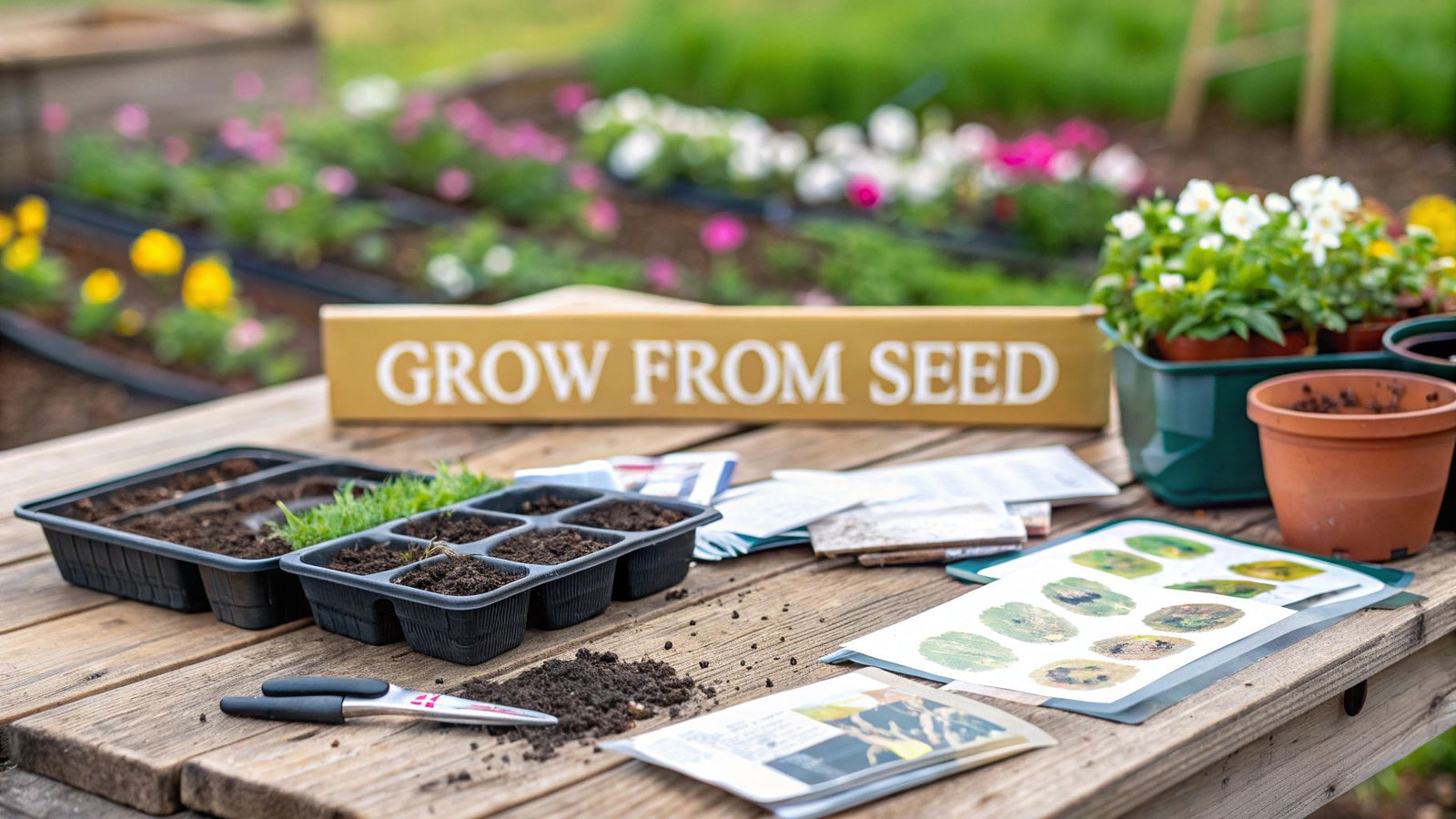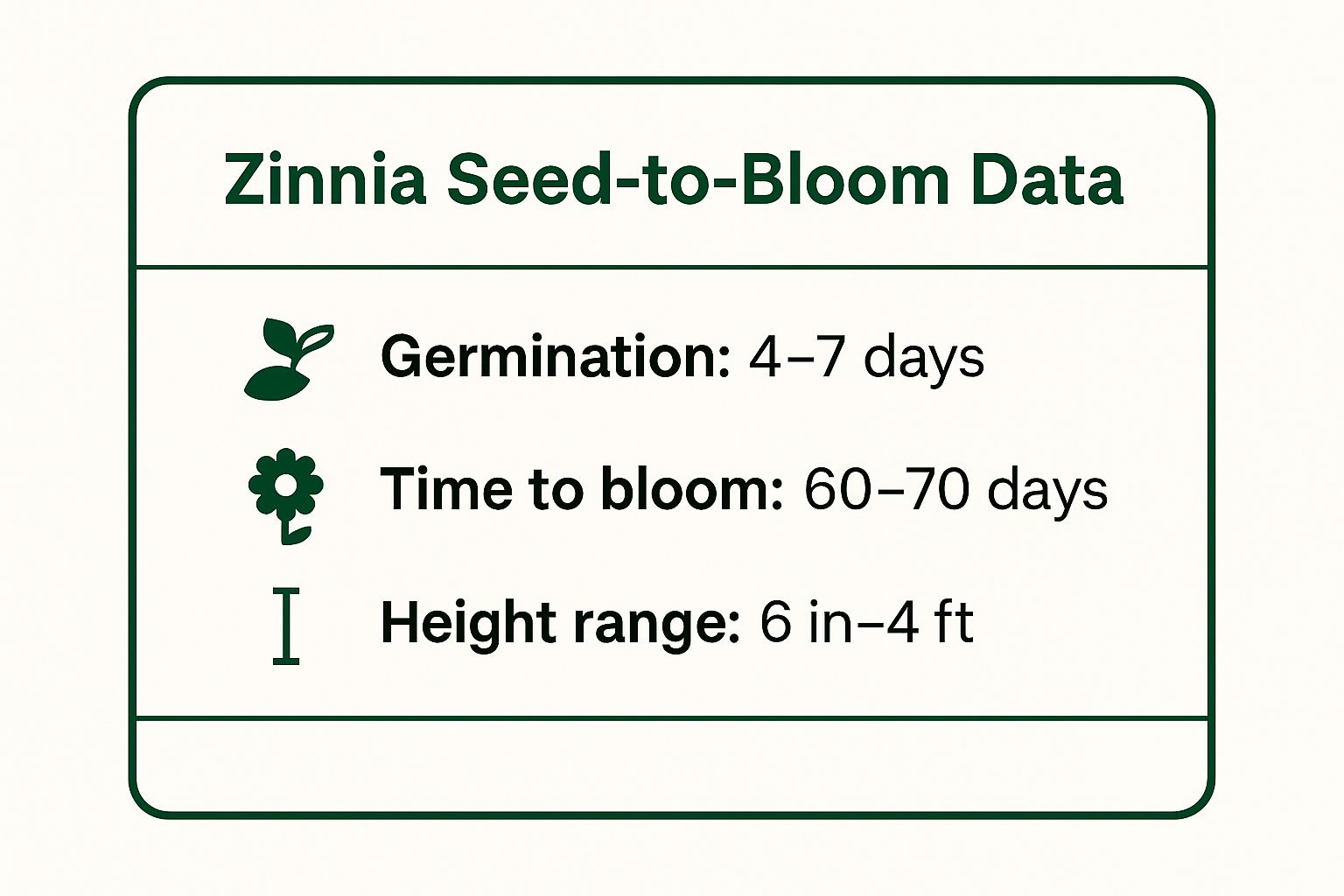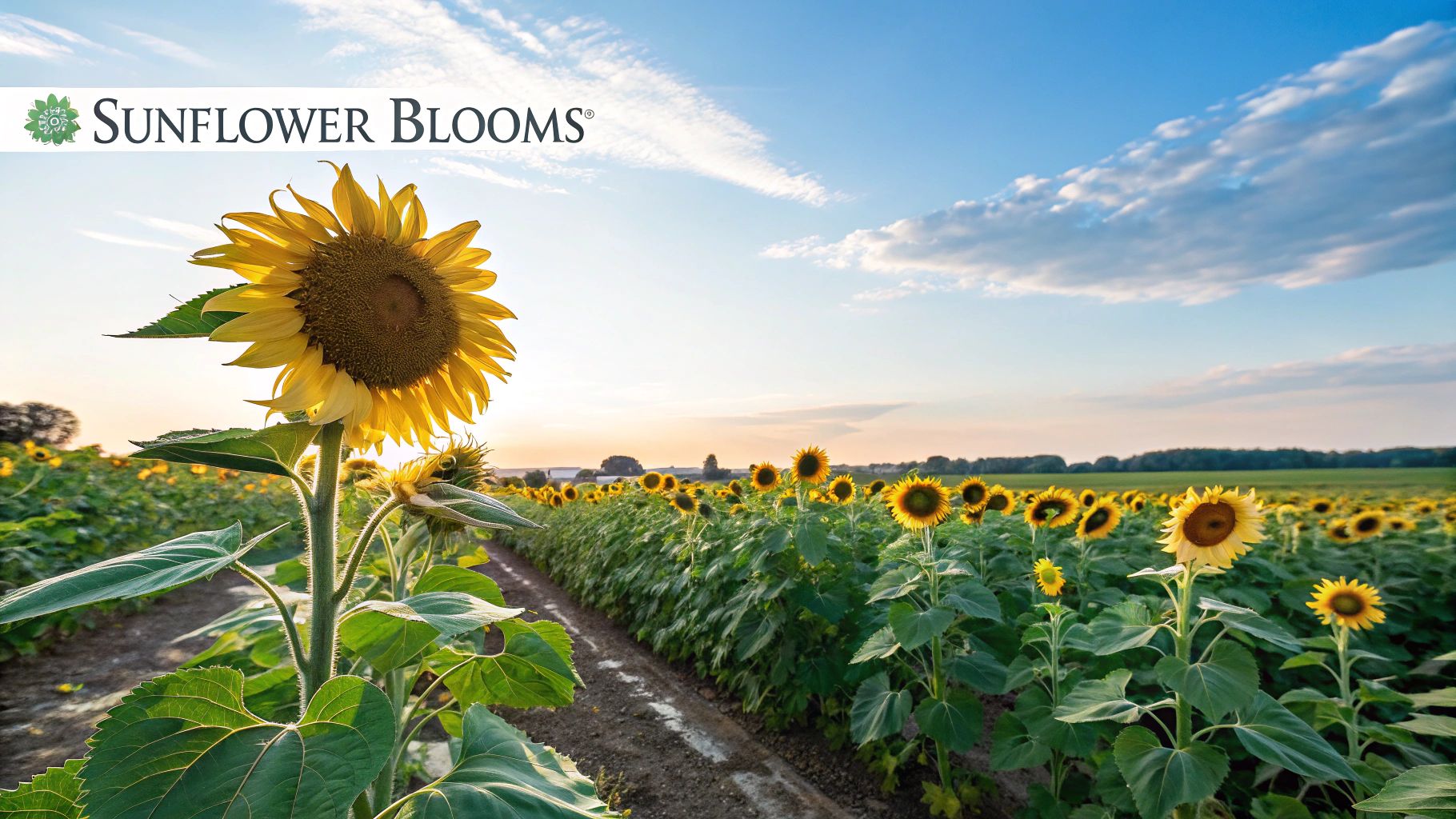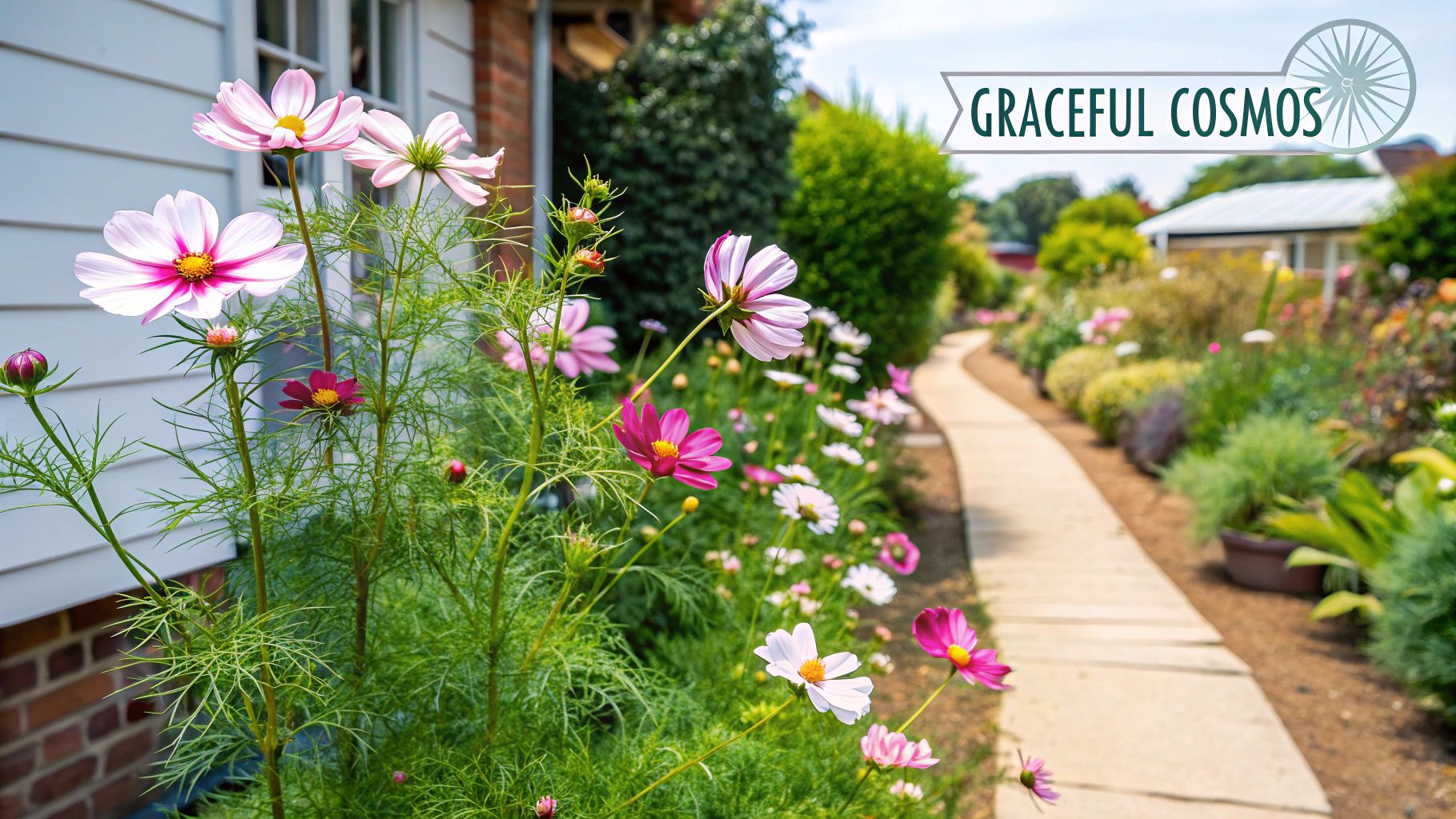
Dreaming of a garden overflowing with vibrant blooms but intimidated by the thought of starting from scratch? The secret to an affordable, abundant, and deeply rewarding garden lies in a simple packet of seeds. Growing flowers from seed is not only a budget-friendly alternative to buying nursery plants, but it also unlocks access to a spectacular variety of colors, forms, and heirloom treasures you won't find in local garden centers. This method connects you directly to the entire lifecycle of a plant, from a tiny, dormant seed to a stunning, mature blossom that you nurtured into existence. It's a gratifying process that puts you in complete control of your garden's design.
This guide demystifies the process by highlighting eight of the best flowers to grow from seed, chosen for their reliability, beauty, and beginner-friendly nature. We will walk you through why each selection is a top choice, providing the actionable tips you need for sowing, growing, and enjoying a season full of homegrown beauty. Whether you have a sprawling yard or a small balcony, this list provides the foundation for transforming your outdoor space one seed at a time. Get ready to discover the simple magic of sowing your own spectacular flower garden.
1. Zinnia (Zinnia elegans)
If you're searching for one of the most dependable and cheerful flowers to grow from seed, look no further than the Zinnia. These vibrant, daisy-like annuals are a beginner's dream, offering an explosion of color with minimal effort. Native to Mexico, Zinnias thrive in the sun and heat, producing continuous blooms from early summer right up until the first frost. Their reliability and quick growth cycle make them a fantastic choice for gardeners seeking instant impact.
Zinnias are incredibly versatile. You'll find them in community gardens where they are used as starter plants for children, and on commercial cut flower farms where tall, sturdy varieties like 'Benary's Giant' are prized for bouquets. Even urban gardeners with limited space can enjoy them, as dwarf varieties like 'Zahara' perform beautifully in containers on a sunny balcony.
Key Growing Insights for Zinnias
To ensure a season full of these prolific bloomers, a few key practices will make all the difference. Good air circulation is crucial for preventing common fungal issues like powdery mildew, so spacing plants correctly is essential.
- Direct Sow or Start Indoors: You can sow seeds directly in the garden after your last frost date, or get a head start by planting them indoors 4-6 weeks earlier.
- Proper Spacing: Allow 6-18 inches between plants, depending on the mature size of your chosen variety. This prevents overcrowding and promotes healthy foliage.
- Watering Technique: Always water at the base of the plant, avoiding the leaves. This simple step is your best defense against fungal diseases.
- Encourage More Blooms: Regularly deadhead, or pinch off, spent flowers. This signals the plant to produce more blooms instead of putting energy into seed production.
Pro Tip: For a continuous supply of fresh flowers all season long, practice succession planting. Sow a new batch of Zinnia seeds every 2-3 weeks from your last frost date through early summer.
This quick reference infographic summarizes the key timeline for growing Zinnias from seed.

As the data shows, the speed from seed to flower is one of the Zinnia's most rewarding traits, making it one of the best flowers to grow from seed for gardeners who want fast and beautiful results.
2. Sunflower (Helianthus annuus)
Symbolizing adoration and loyalty, the sunflower is an iconic, cheerful annual that is remarkably easy to grow from seed, making it a perfect choice for gardeners of all skill levels. These towering, sun-following beauties are native to North America and grow with such speed and vigor that they provide nearly instant gratification. Their simple needs and dramatic presence make them one of the best flowers to grow from seed for creating a bold statement in any garden.

The versatility of sunflowers is impressive. School gardens frequently use 'Mammoth' varieties to teach children about the plant life cycle, while commercial cut flower farms rely on pollen-less 'ProCut' varieties for long-lasting bouquets. Community garden competitions often feature the towering 'Russian Mammoth' to see who can grow the tallest stalk. Planting sunflowers is also rewarding for the wildlife they attract; their seeds are a natural food source, and you can learn more about what wild birds eat to better support your local ecosystem.
Key Growing Insights for Sunflowers
To grow tall, healthy sunflowers with vibrant heads, a few simple techniques will set you up for success. Because they develop a deep taproot, they generally dislike being transplanted, making direct sowing the preferred method. For gardeners in shorter-season climates, you can explore some tips for starting seeds indoors but handle the delicate roots with care.
- Direct Sow for Best Results: Plant seeds directly in the garden after the last frost once the soil has warmed to at least 50°F.
- Planting Depth and Spacing: Sow seeds about 1 inch deep and 6 inches apart. Once seedlings are a few inches tall, thin them to their final recommended spacing, which can be 1-2 feet apart for giant varieties.
- Provide Support Early: For tall varieties, provide a sturdy stake or other support before the plant reaches 3 feet to prevent wind damage.
- Harvesting Seeds: You'll know it's time to harvest when the back of the flower head turns from green to brown and the tiny flowers in the center have shriveled, revealing plump seeds.
Pro Tip: Plant sunflowers in a block or a dense row rather than a single, long line. This formation helps the heavy-headed plants support one another against wind and improves pollination between flowers.
3. Cosmos (Cosmos bipinnatus)
For a touch of ethereal grace and effortless beauty, Cosmos are a must-grow for any gardener. These airy annuals feature delicate, feathery foliage and cheerful, daisy-like blossoms that dance atop slender stems. Native to Mexico, Cosmos are incredibly low-maintenance and drought-tolerant, making them one of the best flowers to grow from seed, especially for those seeking a carefree garden. Their ability to thrive on neglect and often self-sow for future seasons makes them a rewarding and sustainable choice.

The charm of Cosmos lies in their versatility. In cottage gardens, they are perfect filler plants, weaving between perennials to create a soft, romantic tapestry of color. Cut flower growers cherish unique varieties like the 'Cupcakes' or 'Fizzy' series for their distinctive petal shapes. They are even used in meadow restoration projects to provide quick, reliable color while slower-growing native perennials get established. Their simple needs and rapid growth also make them a fantastic choice for children's gardens, guaranteeing a successful and confidence-boosting experience. For more ideas and varieties, you can explore a wide selection of flower seeds online.
Key Growing Insights for Cosmos
To achieve a full season of these whimsical blooms, a few simple guidelines will help your plants flourish. Unlike many other flowers, Cosmos actually perform better in soil that is not overly rich, as too much fertilizer can lead to lush foliage with very few flowers.
- Sowing Method: Direct sow seeds in the garden after all danger of frost has passed. You can also start them indoors 4-6 weeks before your last frost date for earlier blooms.
- Encourage Bushiness: When your plants reach about 12 inches tall, pinch off the top set of leaves. This encourages the plant to branch out, creating a sturdier, fuller plant with more flowers.
- Watering and Feeding: Water regularly until established, but be mindful not to overwater. Avoid high-nitrogen fertilizers; these flowers thrive in average to poor soil.
- Prolong Blooming: Deadhead spent flowers regularly to encourage continuous blooming throughout the summer and into the fall. This also helps control excessive self-seeding if you prefer to manage where they pop up next year.
Pro Tip: Plant Cosmos in a location that receives full sun. While they can tolerate some light shade, full sun exposure results in the strongest stems and the most prolific flower production, preventing the plants from becoming leggy and floppy.
4. Marigold (Tagetes species)
When it comes to foolproof flowers to grow from seed, Marigolds are a classic for good reason. These workhorse annuals are known for their incredibly high germination rates, making them a satisfying and reliable choice for gardeners of all skill levels. Native to Mexico, their cheerful pom-pom blooms in shades of orange, yellow, and red bring a burst of warm color to any garden bed, container, or vegetable patch from summer until the first hard frost.
The utility of Marigolds extends far beyond their beauty. They are a cornerstone of companion planting in organic gardening, widely used to deter common pests. For example, vegetable gardeners often interplant compact French Marigolds with tomatoes to help ward off aphids. On a larger scale, organic farms will plant rows of taller African Marigolds to help suppress root-knot nematodes in the soil, showcasing their practical power.
Key Growing Insights for Marigolds
To get the most out of these vibrant and functional flowers, a few simple practices will ensure they thrive. Promoting a bushy, compact growth habit early on is the key to a full season of prolific blooming.
- Direct Sow or Start Indoors: You can sow seeds directly into the garden once all danger of frost has passed, or get a head start by planting them indoors 6-8 weeks prior.
- Pinch for Bushiness: When seedlings are 4-6 inches tall, pinch off the top set of leaves. This encourages the plant to branch out, resulting in a fuller plant with more flowers.
- Proper Spacing: Give French Marigolds 8-10 inches of space, while larger African varieties will need 12-18 inches to reach their full potential.
- Encourage More Blooms: Regularly deadhead spent flowers. This simple task prevents the plant from going to seed and directs its energy into producing a continuous display of new blooms.
Pro Tip: Marigolds can be used as a "trap crop" for pests like slugs and spider mites. Plant a small patch of them away from your more prized plants to draw these pests away, protecting your main garden.
Their fast, easy growth and dual purpose as both a beautiful flower and a helpful garden ally make Marigolds one of the best flowers to grow from seed, especially for those looking to integrate beauty with function.
5. Sweet Pea (Lathyrus odoratus)
For a touch of romantic, old-fashioned charm and an intoxicating fragrance, Sweet Peas are an unparalleled choice. These cool-season climbing annuals are cherished for their delicate, butterfly-shaped blooms and their exceptional performance as a cut flower. Native to the Mediterranean, they produce cascades of ruffled blossoms in a stunning palette, from soft pastels to rich jewel tones, making them a cottage garden classic.
The allure of the Sweet Pea is timeless. They have been a staple in English gardens since the Victorian era and are grown by cut flower farmers in cooler climates, where long-stemmed 'Spencer' varieties are highly prized for bouquets. Even competitive growers showcase their most perfect blooms at horticultural shows. Their preference for cooler weather makes them one of the best flowers to grow from seed for gardeners in regions like the Pacific Northwest, who can enjoy blooms for months.
Key Growing Insights for Sweet Peas
To cultivate an abundance of these fragrant climbers, a few specific practices are key. Because they are cool-season annuals, timing and preparation are everything. Providing a strong structure for them to climb is essential and should be done at the time of planting.
- Seed Preparation: To improve germination, soak seeds overnight in water or gently nick the hard seed coat with a file or nail clippers before planting.
- Planting Time: Sow seeds in early spring as soon as the soil can be worked. In mild climates (zones 7+), you can also plant them in late fall for an even earlier start.
- Provide Support Early: Install a sturdy trellis, netting, or a bamboo teepee at planting time. The delicate tendrils need something to grab onto as soon as they emerge.
- Encourage More Blooms: This is crucial. You must cut flowers frequently, ideally every 2-3 days. The more you pick, the more the plant will produce.
Pro Tip: Sweet Pea roots love to be cool. Once the weather begins to warm up, apply a thick layer of mulch around the base of the plants to keep the soil cool and moist, which can extend their blooming season significantly.
This video guide offers a great visual overview of how to get your Sweet Peas started for a successful season.
As the video demonstrates, a little bit of early preparation pays off with a profusion of fragrant flowers, securing the Sweet Pea's place as a garden favorite.
6. Nasturtium (Tropaeolum majus)
For a flower that works as hard in the kitchen as it does in the garden, Nasturtium is an unparalleled choice. These wonderfully easy-going annuals are celebrated for their dual-purpose nature, offering both ornamental beauty and culinary delight. Native to South America, Nasturtiums produce unique, round leaves and vibrant, trumpet-shaped flowers in a warm palette of reds, oranges, and yellows. Their unfussy nature makes them one of the best flowers to grow from seed, especially for beginners or those with less-than-ideal soil.
Nasturtiums are incredibly adaptable and serve many roles in the garden. Edible landscape designers often use their mounding or trailing habits as a colorful, low-maintenance groundcover. Vegetable gardeners strategically plant them near beans and brassicas as a "trap crop," as aphids are drawn to the Nasturtiums first. You'll even find their peppery blossoms garnishing salads and desserts in gourmet restaurants, while trailing varieties spill beautifully from hanging baskets and window boxes.
Key Growing Insights for Nasturtiums
To get the most out of these versatile plants, a few specific practices will ensure a bounty of both blooms and edible leaves. Unlike many flowers, Nasturtiums perform best with a bit of neglect, as too much pampering can backfire.
- Direct Sow Only: Nasturtiums have sensitive roots and do not tolerate being transplanted. Sow seeds directly into the garden or their final container after all danger of frost has passed.
- Embrace Poor Soil: Plant them in poor to average, well-draining soil. Overly rich soil or fertilizer will stimulate lush leaf growth at the expense of flowers.
- Soak Seeds: To speed up germination, soak the large seeds in warm water overnight before planting. This helps soften the hard seed coat.
- Harvest for Flavor: For the best peppery flavor, harvest flowers and young leaves in the cool of the morning. You can even let some seed pods mature and pickle them as a substitute for capers.
Pro Tip: Use climbing Nasturtium varieties on a trellis or fence for a stunning vertical accent. Alternatively, let them sprawl between rows in a vegetable patch where they can act as a living mulch, suppressing weeds and conserving soil moisture.
7. Bachelor's Button/Cornflower (Centaurea cyanus)
For a touch of wildflower charm and one of the truest blues in the plant kingdom, Bachelor's Buttons are an unbeatable choice. Also known as Cornflowers, these hardy annuals are incredibly easy to grow from seed, making them a cottage garden classic. Native to Europe, where they historically grew as a common "weed" in corn and grain fields, their frilly, button-like flowers are a symbol of remembrance and rustic beauty.
Bachelor's Buttons are exceptionally versatile and low-maintenance. They are a staple in wildflower meadow mixes, providing early-season color and attracting pollinators. Cut flower growers appreciate them for their long vase life and unique texture, while home gardeners love how they readily self-sow, returning year after year with minimal effort. Their edible petals are also used as a colorful garnish for salads and desserts.
Key Growing Insights for Bachelor's Buttons
These flowers are famously unfussy, but a few simple techniques will guarantee a stunning display. Their preference for cool weather makes them ideal for early spring or even fall sowing, and they strongly dislike being moved once their roots are established.
- Direct Sow for Best Results: Bachelor's Buttons have a sensitive taproot and do not transplant well. Sow seeds directly into the garden where you want them to grow. You can plant in late fall for earlier blooms or in early spring as soon as the soil is workable.
- Succession Planting: For a continuous harvest of fresh blooms, sow new seeds every 2-3 weeks from early spring through the beginning of summer.
- Provide Full Sun & Good Drainage: These plants need at least 6 hours of direct sunlight to produce the strongest stems and most abundant flowers. They are not picky about soil but require good drainage.
- Thin Seedlings: Once seedlings are a few inches tall, thin them to be 6-8 inches apart. This spacing is crucial for promoting good air circulation and preventing potential disease issues.
Pro Tip: To harvest for bouquets, cut the stems when the flowers are just beginning to open but are not yet fully flat. This will significantly extend their vase life. If you want them to self-sow for next year, simply leave a few of the last flowers on the plants to go to seed.
8. California Poppy (Eschscholzia californica)
For gardeners seeking a touch of wildflower charm with almost no effort, the California Poppy is an unbeatable choice. These cheerful, drought-tolerant natives are among the easiest and best flowers to grow from seed, bringing silky, cup-shaped blooms to even the most challenging garden spots. As the state flower of California, they are perfectly adapted to thrive in sun and poor soil, creating a sea of vibrant orange, yellow, and red from spring into early summer.
California Poppies are incredibly resilient and versatile. Highway departments in the Western U.S. use them for beautification and erosion control along roadsides, while landscape designers feature them in mass plantings for low-water gardens. They are also a perfect fit for rock gardens, where their blue-green, feathery foliage and bright blooms provide stunning early-season color. Their ability to self-sow makes them a fantastic, low-maintenance groundcover for native plant gardens.
Key Growing Insights for California Poppies
To get a spectacular display from these fuss-free flowers, the key is to mimic their native growing conditions: lean soil, minimal water, and plenty of sun. They have a delicate taproot, which means they resent being transplanted.
- Direct Sow Only: Scatter seeds directly onto prepared soil in late fall (for mild climates) or early spring as soon as the ground can be worked. Avoid starting them indoors.
- Light for Germination: Barely cover the seeds with a dusting of soil, as they need some light to germinate properly. Gently press them into the soil to ensure good contact.
- Minimal Care Required: Plant in a spot with full sun and well-drained, average-to-poor soil. Avoid rich soil and fertilizer, which can lead to more foliage and fewer flowers.
- Water Sparingly: Overwatering is a common mistake that can cause root rot. Water only during prolonged dry spells once plants are established.
Pro Tip: Let the flowers go to seed at the end of their bloom cycle. The pods will dry, pop open, and scatter seeds, ensuring a new, free crop of poppies for the following year.
The "sow and forget" nature of this plant is what makes it one of the most rewarding flowers to grow from seed. For more guidance on establishing a natural-looking patch, you can learn more about how to sow and grow wildflowers. This simple approach will give you a beautiful, self-sustaining patch of color year after year.
Top 8 Flower Seeds Comparison
| Flower | Implementation Complexity 🔄 | Resource Requirements ⚡ | Expected Outcomes 📊 | Ideal Use Cases 💡 | Key Advantages ⭐ |
|---|---|---|---|---|---|
| Zinnia (Zinnia elegans) | Low - Easy germination and growth; beginner-friendly | Low - Needs full sun and occasional staking | Vibrant, continuous blooms for summer to frost; strong pollinator attractant | Community gardens, cut flower farms, containers | Fast germination, heat & drought tolerant, long vase life |
| Sunflower (Helianthus annuus) | Medium - Requires staking for tall types; large spacing | Moderate - Nutrient rich soil needed; support for tall plants | Tall dramatic blooms with edible seeds and soil benefits | Educational gardens, privacy screens, commercial seed | Rapid growth, size variety, dual ornamental & edible use |
| Cosmos (Cosmos bipinnatus) | Low - Easy to grow; minimal staking needed | Low - Tolerates poor soil and drought | Abundant, long-lasting flowers with self-sowing habit | Cottage gardens, meadow restoration, naturalistic beds | Drought tolerant, prolific blooms, self-sowing |
| Marigold (Tagetes species) | Low - Nearly 100% germination, compact growth | Low - Minimal fertilizer; compact spacing | Reliable, long blooming season with pest-repellent properties | Vegetable gardens, organic farms, containers | Natural pest deterrent, continuous blooms, beginner-friendly |
| Sweet Pea (Lathyrus odoratus) | Medium - Seeds need soaking; must provide climbing support | Moderate - Requires cool temperatures and trellises | Fragrant, abundant cut flowers with vertical growth | Cool-season gardens, cut flower cultivation, cottage gardens | Exceptional fragrance, vertical growth saves space |
| Nasturtium (Tropaeolum majus) | Low - Easy germination, dislikes transplanting | Low - Thrives in poor soil, minimal care | Continuous blooms; edible flowers and leaves | Edible landscapes, beginner gardeners, container gardens | Edible and ornamental, aphid trap plant, drought tolerant |
| Bachelor's Button/Cornflower | Low - Easy to grow; self-sowing; occasional staking | Low - Thrives in poor soil, minimal maintenance | True-blue flowers; good cut and dried flower; self-sows | Wildflower meadows, memorial gardens, cottage gardens | Rare blue flowers, cold-hardy, reliable self-sower |
| California Poppy (Eschscholzia) | Low - Very easy to grow; avoid transplanting | Low - Prefers poor, dry soil; low water needs | Long blooming, drought-tolerant wildflower carpet | Xeriscape gardens, erosion control, wildflower meadows | Exceptional drought tolerance, long bloom, low maintenance |
Your Homegrown Flower Garden Awaits
Starting a garden from a simple packet of seeds is one of the most rewarding journeys a gardener can undertake. From the first tiny sprout to the final, brilliant bloom, you become a direct participant in the life cycle of your garden. This list of eight of the best flowers to grow from seed was carefully curated to ensure your success, offering a vibrant palette of colors, shapes, and sizes perfect for beginners and seasoned growers alike.
We explored the unstoppable cheerfulness of Zinnias and Sunflowers, the delicate, airy nature of Cosmos, and the pest-repelling power of Marigolds. Each flower on this list, from the fragrant, climbing Sweet Pea to the edible and beautiful Nasturtium, offers a unique benefit beyond its visual appeal. They attract essential pollinators, provide endless bouquets for your home, and connect you more deeply to the rhythms of the seasons.
4 Key Takeaways for Seed-Starting Success
The core lesson is simple: success begins with the right seed in the right place. Understanding a few fundamental principles will transform your gardening experience from one of chance to one of confidence.
- 1. Know Your Zone: Always check your USDA Plant Hardiness Zone. This crucial piece of information dictates when you can safely plant seeds outdoors and which varieties will thrive in your local climate.
- 2. Sunlight is Non-Negotiable: As we saw with Sunflowers and California Poppies, "full sun" means at least 6-8 hours of direct, unfiltered sunlight. Assess your garden space honestly before you sow.
- 3. Soil Preparation Matters: Whether you’re amending garden beds with compost or using a specialized seed-starting mix for indoor trays, healthy soil provides the foundation for robust plants. Good drainage is just as important as nutrients.
- 4. Follow the Packet: Seed packets are your most valuable guide. They provide specific, expert advice on planting depth, spacing, and ideal germination temperatures tailored to that exact variety.
Your 3-Step Action Plan for a Blooming Garden
Feeling inspired? Don't let the momentum fade. Your journey to a beautiful, seed-grown garden starts with a single, simple step.
- Choose Your Flowers: This week, choose one or two flowers from this list that captured your imagination. Perhaps it’s the low-maintenance Bachelor's Button for a wildflower patch or the versatile Cosmos for filling in gaps along a fence line.
- Get Your Seeds: Once you have your chosen varieties, your next step is to acquire the seeds.
- Prepare Your Space: You don't need a massive plot of land; a few containers on a sunny balcony can be just as productive and beautiful. The simple act of planting a seed is an investment in future beauty, a hopeful gesture that promises a season filled with color, life, and the deep satisfaction of having grown it all yourself. The most beautiful gardens are not born from luck, but from the decision to begin.
Ready to turn this inspiration into a reality? The curated heirloom and organic seed collections at Homegrown Garden provide the perfect starting point for your floral adventure. Explore our vibrant selection of the best flowers to grow from seed and find everything you need to cultivate a stunning, sustainable garden. Find your perfect seeds at Homegrown Garden and start your growing journey today



